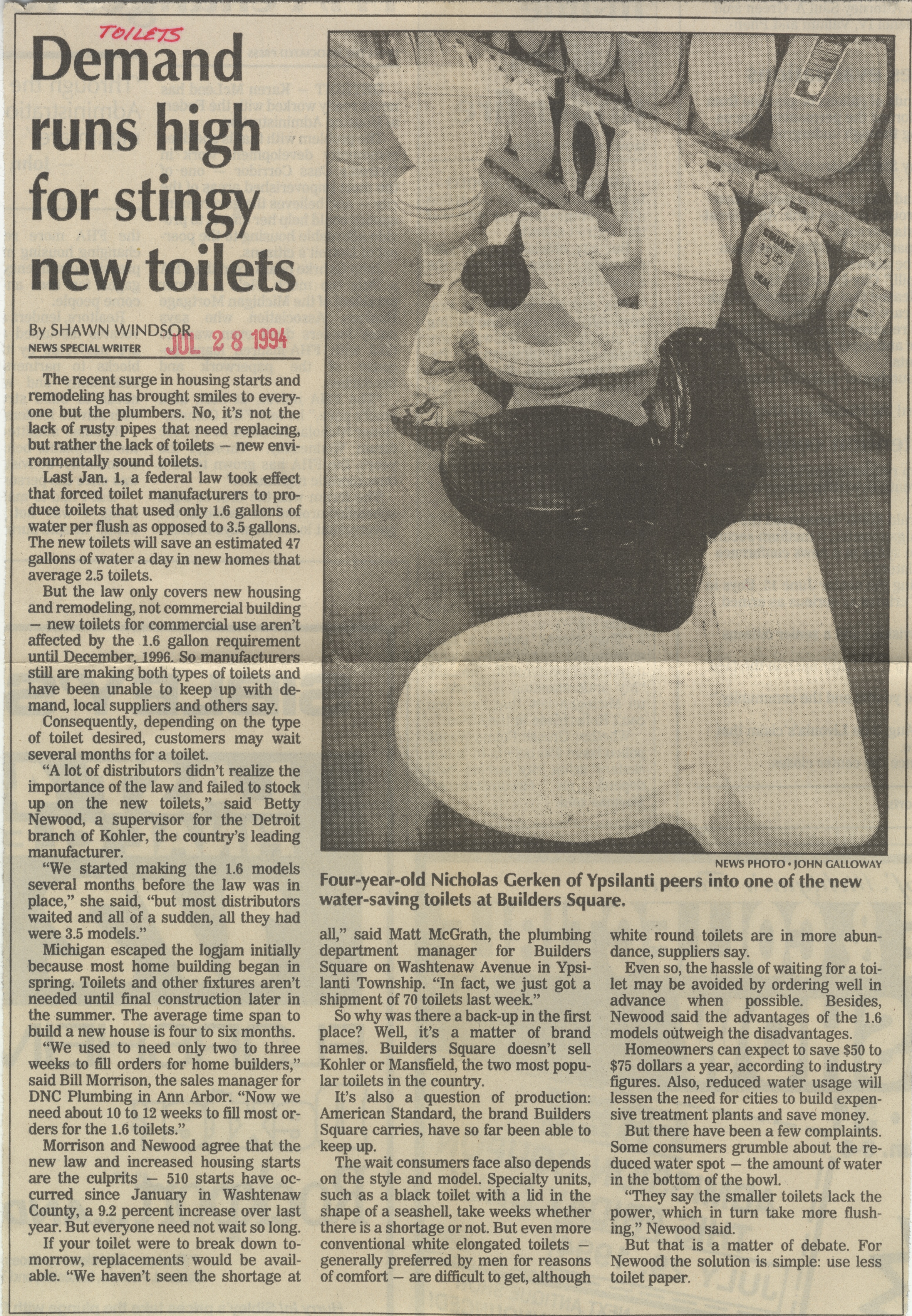Demand Runs High For Stingy New Toilets

Demand runs high for stingy new toilets
By SHAWN WINDSOR
NEWS SPECIAL WRITER JUL 28 1994
The recent surge in housing starts and remodeling has brought smiles to everyone but the plumbers. No, it’s not the lack of rusty pipes that need replacing, but rather the lack of toilets - new environmentally sound toilets.
Last Jan. 1, a federal law took effect that forced toilet manufacturers to produce toilets that used only 1.6 gallons of water per flush as opposed to 3.5 gallons. The new toilets will save an estimated 47 gallons of water a day in new homes that average 2.5 toilets.
But the law only covers new housing and remodeling, not commercial building - new toilets for commercial use aren’t affected by the 1.6 gallon requirement until December, 1996. So manufacturers still are making both types of toilets and have been unable to keep up with demand, local suppliers and others say.
Consequently, depending on the type of toilet desired, customers may wait several months for a toilet.
“A lot of distributors didn’t realize the importance of the law and failed to stock up on the new toilets,” said Betty Newood, a supervisor for the Detroit branch of Kohler, the country's leading manufacturer.
“We started making the 1.6 models several months before the law was in place,” she said, “but most distributors waited and all of a sudden, all they had were 3.5 models.”
Michigan escaped the logjam initially because most home building began in spring. Toilets and other fixtures aren’t needed until final construction later in the summer. The average time span to build a new house is four to six months.
“We used to need only two to three weeks to fill orders for home builders,” said Bill Morrison, the sales manager for DNC Plumbing in Ann Arbor. “Now we need about 10 to 12 weeks to fill most orders for the 1.6 toilets.”
Morrison and Newood agree that the new law and increased housing starts are the culprits - 510 starts have occurred since January in Washtenaw County, a 9.2 percent increase over last year. But everyone need not wait so long.
If your toilet were to break down tomorrow, replacements would be available. “We haven’t seen the shortage at all,” said Matt McGrath, the plumbing department manager for Builders Square on Washtenaw Avenue in Ypsilanti Township. “In fact, we just got a shipment of 70 toilets last week.”
NEWS PHOTO • JOHN GALLOWAY
Four-year-old Nicholas Gerken of Ypsilanti peers into one of the new water-saving toilets at Builders Square.
So why was there a back-up in the first place? Well, it’s a matter of brand names. Builders Square doesn’t sell Kohler or Mansfield, the two most popular toilets in the country.
It’s also a question of production: American Standard, the brand Builders Square carries, have so far been able to keep up.
The wait consumers face also depends on the style and model. Specialty units, such as a black toilet with a lid in the shape of a seashell, take weeks whether there is a shortage or not. But even more conventional white elongated toilets - generally preferred by men for reasons of comfort - are difficult to get, although white round toilets are in more abundance, suppliers say.
Even so, the hassle of waiting for a toilet may be avoided by ordering well in advance when possible. Besides, Newood said the advantages of the 1.6 models outweigh the disadvantages.
Homeowners can expect to save $50 to $75 dollars a year, according to industry figures. Also, reduced water usage will lessen the need for cities to build expensive treatment plants and save money.
But there have been a few complaints. Some consumers grumble about the reduced water spot - the amount of water in the bottom of the bowl.
“They say the smaller toilets lack the power, which in turn take more flushing,” Newood said.
But that is a matter of debate. For Newood the solution is simple: use less toilet paper.